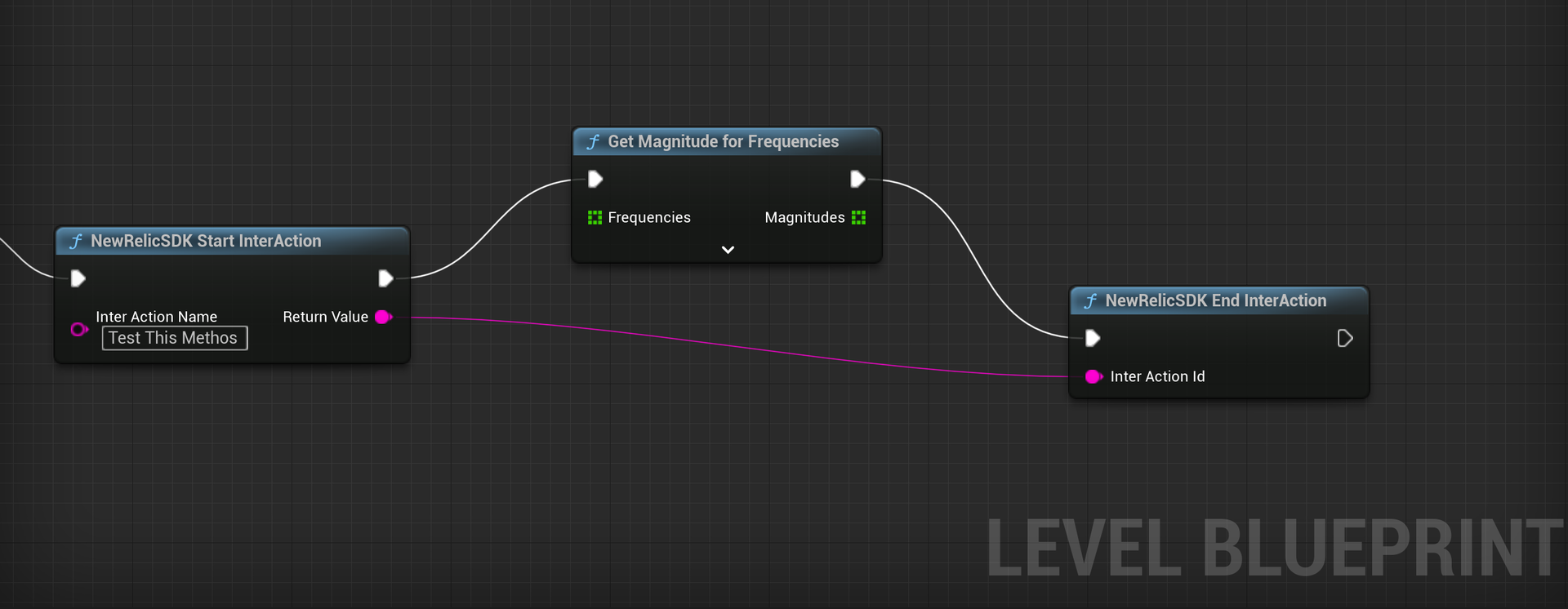Syntaxe
Java
NewRelic.endInteraction(string $interactionID)Kotlin [#kotlin]
NewRelic. endInteraction(id : String!)Description [#description]
New Relic met fin automatiquement à toutes les interactions, mais vous pouvez utiliser endInteraction() pour mettre fin plus tôt à une interaction personnalisée. L'ID de chaîne est renvoyé lorsque vous utilisez l'appel startInteraction() .
Cet appel n'a aucun effet si l'interaction est déjà terminée.
Paramètres [#parameters]
paramètres | Type | Description |
|---|---|---|
|
| Requis. La valeur renvoyée par |
Exemple [#example]
Voici un exemple de fin d'une interaction personnalisée RefreshContacts:
Java [#java]
public class MainActivity extends Activity { ... @Override public boolean onOptionsItemSelected(MenuItem item) { switch (item.getItemId()) { case R.id.action_refresh: String interactionId = NewRelic.startInteraction("RefreshContacts"); ... return true; default: NewRelic.endInteraction(interactionId); return super.onOptionsItemSelected(item); } } ...}Syntaxe
Objectif-C
+ (void) stopCurrentInteraction:(NSString*)interactionIdentifier;Swift [#swift]
NewRelic.stopInteraction(string: "myInteractionName")Description [#description]
Cette méthode arrêtera la trace d'interaction associée au interactionIdentifier (qui est renvoyé par la méthode startInteractionWithName: ). Il n'est pas nécessaire d'appeler cette méthode pour compléter une trace d'interaction (une trace d'interaction se complétera intelligemment d'elle-même). Cependant, utilisez cette méthode si vous souhaitez une période d’interaction plus discrète.
Paramètres [#parameters]
paramètres | Type | Description |
|---|---|---|
|
| Requis. La valeur renvoyée par |
Exemples [#examples]
Objective-C [#obj-c]
NSString *identifier = [NewRelic startInteractionWithName: @"myInteractionName"];[NewRelic stopCurrentInteraction: identifier];Swift [#swift]
let identifier = NewRelic.startInteraction(withName: "myInteractionName")NewRelic.stopCurrentInteraction(identifier)Syntaxe
endInteraction(options: { interactionId: string; }) => voidDescription [#description]
Ceci utilise l'ID de chaîne pour l'interaction que vous souhaitez terminer. Cette chaîne est renvoyée lorsque vous utilisez startInteraction().
Paramètres [#parameters]
paramètres | Type | Description |
|---|---|---|
|
| Requis. La valeur renvoyée par |
Exemple [#example]
const badApiLoad = async () => { const id = await NewRelicCapacitorPlugin.startInteraction({ value: 'StartLoadBadApiCall' }); console.log(id); const url = 'https://fakewebsite.com/moviessssssssss.json'; fetch(url) .then((response) => response.json()) .then((responseJson) => { console.log(responseJson); NewRelicCapacitorPlugin.endInteraction({ interactionId: id.value }); }) .catch((error) => { NewRelicCapacitorPlugin.endInteraction({ interactionId: id.value }); console.error(error); });};Syntaxe
endInteraction(id: InteractionId): void;Description [#description]
Ceci utilise l'ID de chaîne pour l'interaction que vous souhaitez terminer. Cette chaîne est renvoyée lorsque vous utilisez startInteraction().
Paramètres [#parameters]
paramètres | Type | Description |
|---|---|---|
|
| Requis. La valeur renvoyée par |
Exemple [#example]
const badApiLoad = async () => { const interactionId = await NewRelic.startInteraction('StartLoadBadApiCall'); console.log(interactionId); const url = 'https://cordova.apache.org/moviessssssssss.json'; fetch(url) .then((response) => response.json()) .then((responseJson) => { console.log(responseJson); NewRelic.endInteraction(interactionId); }) .catch((error) => { NewRelic.endInteraction(interactionId); console.error(error); });Syntaxe
EndInteraction(string interactionId): void;Description [#description]
Ceci utilise l'ID de chaîne pour l'interaction que vous souhaitez terminer. Cette chaîne est renvoyée lorsque vous utilisez startInteraction().
Paramètres [#parameters]
paramètres | Type | Description |
|---|---|---|
|
| Requis. La valeur renvoyée par |
Exemple [#example]
HttpClient myClient = new HttpClient(CrossNewRelic.Current.GetHttpMessageHandler());string interactionId = CrossNewRelic.Current.StartInteraction("Getting data from service");var response = await myClient.GetAsync(new Uri("https://jsonplaceholder.typicode.com/todos/1"));
if (response.IsSuccessStatusCode){ var content = await response.Content.ReadAsStringAsync();} else{ Console.WriteLine("Unsuccessful response code");}
CrossNewRelic.Current.EndInteraction(interactionId);Syntaxe
endInteraction(String interactionId): void;Description [#description]
Ceci utilise l'ID de chaîne pour l'interaction que vous souhaitez terminer. Cette chaîne est renvoyée lorsque vous utilisez startInteraction().
Paramètres [#parameters]
paramètres | Type | Description |
|---|---|---|
|
| Requis. La valeur renvoyée par |
Exemple [#example]
var id = await NewrelicMobile.instance.startInteraction("Getting Data from Service");
try { var dio = Dio(); var response = await dio.get( 'https://reqres.in/api/users?delay=15'); print(response); NewrelicMobile.instance.endInteraction(id); Timeline.finishSync();} catch (e) { print(e);}Syntaxe
endInteraction(id: InteractionId): void;Description [#description]
Ceci utilise l'ID de chaîne pour l'interaction que vous souhaitez terminer. Cette chaîne est renvoyée lorsque vous utilisez startInteraction().
Paramètres [#parameters]
paramètres | Type | Description |
|---|---|---|
|
| Requis. La valeur renvoyée par |
Exemple [#example]
const badApiLoad = async () => { const interactionId = await NewRelic.startInteraction('StartLoadBadApiCall'); console.log(interactionId); const url = 'https://facebook.github.io/react-native/moviessssssssss.json'; fetch(url) .then((response) => response.json()) .then((responseJson) => { console.log(responseJson); NewRelic.endInteraction(interactionId); }) .catch((error) => { NewRelic.endInteraction(interactionId); console.error(error); });;};Syntaxe
StopCurrentInteraction(string interactionId): void;Description [#description]
Ceci utilise l'ID de chaîne pour l'interaction que vous souhaitez terminer. Cette chaîne est renvoyée lorsque vous utilisez startInteraction().
Paramètres [#parameters]
paramètres | Type | Description |
|---|---|---|
|
| Requis. La valeur renvoyée par |
Exemple [#example]
string interActionId = NewRelicAgent.StartInteractionWithName("Unity InterAction Example");
for(int i =0; i < 4;i++){ Thread.Sleep(1000);}
NewRelicAgent.StopCurrentInteraction(interActionId);Syntaxe
endInterAction(FString interActionId): void;Description [#description]
Ceci utilise l'ID de chaîne pour l'interaction que vous souhaitez terminer. Cette chaîne est renvoyée lorsque vous utilisez startInteraction().
Paramètres [#parameters]
paramètres | Type | Description |
|---|---|---|
|
| Requis. La valeur renvoyée par |
Exemple [#example]
#include "NewRelicBPLibrary.h"
FString id = UNewRelicBPLibrary::startInterAction("test Unreal InterAction");
FPlatformProcess::Sleep(6.0);
UNewRelicBPLibrary::endInterAction(id);
Syntaxe
EndInteraction(string interactionId): void;Description [#description]
Ceci utilise l'ID de chaîne pour l'interaction que vous souhaitez terminer. Cette chaîne est renvoyée lorsque vous utilisez startInteraction().
Paramètres [#parameters]
paramètres | Type | Description |
|---|---|---|
|
| Requis. La valeur renvoyée par |
Exemple [#example]
HttpClient myClient = new HttpClient(CrossNewRelicClient.Current.GetHttpMessageHandler());
string interactionId = CrossNewRelicClient.Current.StartInteraction("Getting data from service");var response = await myClient.GetAsync(new Uri("https://jsonplaceholder.typicode.com/todos/1"));
if (response.IsSuccessStatusCode){ var content = await response.Content.ReadAsStringAsync();}else{ Console.WriteLine("Unsuccessful response code");}
CrossNewRelicClient.Current.EndInteraction(interactionId);